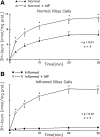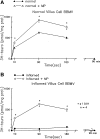Glucocorticoids differentially regulate Na-bile acid cotransport in normal and chronically inflamed rabbit ileal villus cells
- PMID: 20075140
- PMCID: PMC2867427
- DOI: 10.1152/ajpgi.00176.2009
Glucocorticoids differentially regulate Na-bile acid cotransport in normal and chronically inflamed rabbit ileal villus cells
Abstract
Previous studies have demonstrated that apical Na-bile acid cotransport (ASBT) is inhibited during chronic ileitis by both a decrease in the affinity as well as a decrease in the number of cotransporters. Methylprednisolone (MP), a commonly used treatment for inflammatory bowel disease (IBD, e.g., Crohn's disease), has been shown to reverse the inhibition of several other Na-solute cotransporters during chronic enteritis. However, the effect of MP on ASBT in the chronically inflamed ileum is not known. MP stimulated ASBT in villus cells from the normal rabbit ileum by increasing the cotransporter expression without a change in the affinity of the cotransporter for bile acid. Western blot studies demonstrated an increase in cotransporter expression. MP reversed the inhibition of ASBT in villus cells from the chronically inflamed ileum. Kinetic studies demonstrated that the mechanism of MP-mediated reversal of ASBT inhibition was secondary to a restoration of both affinity as well as cotransporter numbers. Western blot analysis demonstrated restoration of cotransporter numbers after MP treatment of rabbits with chronic ileitis. Thus MP stimulates ASBT in the normal ileum by increasing cotransporter numbers. MP reverses the inhibition of ASBT during chronic ileitis. However, MP restores the diminished affinity as well as cotransporter expression levels during chronic ileitis. Thus MP differentially regulates ASBT in the normal and in the chronically inflamed ileum.
Figures







Similar articles
-
Corticosteroids reverse the inhibition of Na-glucose cotransport in the chronically inflamed rabbit ileum.Am J Physiol. 1999 Jan;276(1):G211-8. doi: 10.1152/ajpgi.1999.276.1.G211. Am J Physiol. 1999. PMID: 9886998
-
Mechanism of inhibition of Na+-bile acid cotransport during chronic ileal inflammation in rabbits.Am J Physiol. 1998 Dec;275(6):G1259-65. doi: 10.1152/ajpgi.1998.275.6.G1259. Am J Physiol. 1998. PMID: 9843761
-
Neutral Na-amino acid cotransport is differentially regulated by glucocorticoids in the normal and chronically inflamed rabbit small intestine.Am J Physiol Gastrointest Liver Physiol. 2007 Feb;292(2):G467-74. doi: 10.1152/ajpgi.00503.2005. Am J Physiol Gastrointest Liver Physiol. 2007. PMID: 17290012
-
Intestinal bile acid transport: biology, physiology, and pathophysiology.J Pediatr Gastroenterol Nutr. 2001 Apr;32(4):407-17. doi: 10.1097/00005176-200104000-00002. J Pediatr Gastroenterol Nutr. 2001. PMID: 11396803 Review.
-
ASBT(SLC10A2): A promising target for treatment of diseases and drug discovery.Biomed Pharmacother. 2020 Dec;132:110835. doi: 10.1016/j.biopha.2020.110835. Epub 2020 Oct 6. Biomed Pharmacother. 2020. PMID: 33035828 Review.
Cited by
-
Intestinal Absorption of Bile Acids in Health and Disease.Compr Physiol. 2019 Dec 18;10(1):21-56. doi: 10.1002/cphy.c190007. Compr Physiol. 2019. PMID: 31853951 Free PMC article. Review.
-
Chronic and selective inhibition of basolateral membrane Na-K-ATPase uniquely regulates brush border membrane Na absorption in intestinal epithelial cells.Am J Physiol Cell Physiol. 2015 Apr 15;308(8):C650-6. doi: 10.1152/ajpcell.00355.2014. Epub 2015 Feb 4. Am J Physiol Cell Physiol. 2015. PMID: 25652450 Free PMC article.
-
Inducible Nitric Oxide Regulates Na-Glucose Co-transport in a Spontaneous SAMP1/YitFc Mouse Model of Chronic Ileitis.Nutrients. 2020 Oct 13;12(10):3116. doi: 10.3390/nu12103116. Nutrients. 2020. PMID: 33065982 Free PMC article.
-
Mechanism of Dyslipidemia in Obesity-Unique Regulation of Ileal Villus Cell Brush Border Membrane Sodium-Bile Acid Cotransport.Cells. 2019 Oct 3;8(10):1197. doi: 10.3390/cells8101197. Cells. 2019. PMID: 31623375 Free PMC article.
-
The solute carrier family 10 (SLC10): beyond bile acid transport.Mol Aspects Med. 2013 Apr-Jun;34(2-3):252-69. doi: 10.1016/j.mam.2012.07.004. Mol Aspects Med. 2013. PMID: 23506869 Free PMC article. Review.
References
-
- Ausubel FM, Kingston RE, Moore DD, Seidman JG, Smith JA, Stuhl K. Current Protocols in Molecular Biology New York: John Wiley & Sons, 1995
-
- Barnard JA, Ghishan FK. Methylprednisolone accelerates the ontogeny of sodium-taurocholate cotransport in rat ileal brush border membranes. J Lab Clin Med 108: 549–555, 1986 - PubMed
-
- Castro G. Immunological Regulation of Electrolyte Transport New York: Raven, 1990, p. 31–46
-
- Chen F, Ma L, Al-Ansari N, Shneider B. The role of AP-1 in the transcriptional regulation of the rat apical sodium-dependent bile acid transporter. J Biol Chem 276: 38703–38714, 2001 - PubMed
-
- Chen X, Chen F, Liu S, Glaeser H, Dawson PA, Hofmann AF, Kim RB, Shneider BL, Pang KS. Transactivation of rat apical sodium-dependent bile acid transporter and increased bile acid transport by 1alpha,25-dihydroxyvitamin D3 via the vitamin D receptor. Mol Pharmacol 69: 1913–1923, 2006 - PubMed
Publication types
MeSH terms
Substances
Grants and funding
LinkOut - more resources
Full Text Sources
Medical

